Like most women growing up in the 1950s and 1960s I was fed a generous serving of sugar-coated media stereotypes of happy homemakers who were as frozen and neatly packaged as the processed foods they served their cold war families
The Feminine Mistake 1960
In the years before I went to Kindergarten, I shadowed my mother Betty everywhere she went.
Within her suburban sphere of influence I was a contented little satellite, spinning in her orbit.
Whether shopping or schlepping, picking up or dropping off, I would follow in her footsteps…literally. The task I enjoyed tagging along with the most was her weekly appointment at the Glam-A-Rama Beauty Parlor.
Glam-A- Rama Beauty Parlor
The beauty parlor was a unique universe unlike any place else, where unfamiliar, strange-looking equipment was being used by familiar neighborhood women looking strange.
All dressed alike, their ordinary clothes replaced by identical leopard print smocks, it was a universe with its own uniform.
A universe where gossip was as hot and swift as the air blowing through the missile shaped hairdryers, a world where I was privy to carefully guarded grown up secrets.
Strange intimacies grew between women who organized carpools and now found themselves sitting, captive under pink hair dryers.
These conversations were unlike the hurried confidences exchanged as Friday’s schedule was switched with Tuesdays, pick-ups and deliveries reversed, or when a tired mother deposits the last child and stayed for a quick cup of instant coffee.
It was over the roar of the dryers in the afternoons while casseroles simmered in automatic ovens back home that these women gave full voice to secret whispering fears. Somehow dread words could be spoken and reassurances offered.
In the shadow of the hairdryers, as nails were polished, calluses scraped and hair teased, dread words could be safely spoken.
Post War Periodicals
Sinking into a padded turquoise swivel styling chair, I sat next to Mom, carefully watching as Miss Blanche the hairdresser, combed and teased, bombarding Mom with hairspray.
This was truly a space age hair-do with its propulsion accomplished by strenuous backcombing.
Mom would sit in the hydraulic chair reading 2 month old, dog-eared copies of McCalls and Good Housekeeping, while Miss Blanche maintaining a steady flow of mindless chatter as she worked.
Magazine Madness
Tucked within those pages, the periodicals promised the modern mid-century housewife would find exactly the right information and products that would give her the knowledge to excel in her role as wife and mother.
Glancing at her favorite magazines at the Glama-Rama only seemed to confirm what Mom knew in her heart to be true- that love, marriage, and children is The career for women.
“Yes,” she would read, nodding in agreement “for today’s homemaker her home is her castle.”
“Snug within it she basks in the warmth of a good mans love…glories in the laughter of healthy children…glows with pride in every new acquisition that adds color or comfort pleasure or leisure to her family’s life.”
“And, she’s always there! She’s an up to date modern American homemaker.”
Breathing in deeply of the beauty parlor air heavy with the cloying sweetness of perfume diluted by the acrid smell of singed hair, Mom sighed contently.
Home Work
Of course, the gals all agreed, some poor mothers had to work to provide for their families.
The big talk that day that set tongues wagging concerned Shirley Birnbaum who was pregnant and planned to go back to work as a teacher after she had a baby!
“But the ones I’d like to talk about,” our neighbor Estelle Wolfson said between puffs of her Parliament pointing to an article in one magazine, “are those who feel that household and community activities are for “squares.”
The curler clad ladies nodded in unison.
Can This Marriage Be Saved
By the fall of 1960 there had began to appear some quiet rumblings among some unhappy housewives across the country.
Now and again Mom would read an article, usually in the Can This Marriage be Saved column, about those few unfortunate women who felt stifled and lonely in their marriage.
“Feminists” or anyone who couldn’t find fulfillment in the Lady Clairol colorful cold war world of carpools, cookouts, cream of mushroom soup casseroles, and catering to contented children and happy-go-lucky husbands, were disturbed.
Flipping through one magazine, she noticed that September’s Redbook offered a $500 prize for the best essay on “Why Young Mothers Feel Trapped.”
It triggered an unexpectedly large response 24,000 entries.
Another magazine, Good Housekeeping also tapped into this vein of unhappiness with a September article of its own. “I Say: Women Are People Too.”
The article caught Moms eye.
It noted “a strange stirring, a dissatisfied groping, a yearning” by American women, a sense that there must be more to life than raising children and maintaining a clean comfortable home.
The magazine urged its readers to overcome their malaise by taking charge of their lives. “She can’t live through her husband and children.” It said of the typical housewife. “They are separate selves. She has to find her own fulfillment first.”
The author of the Good Housekeeping article was by another Betty, Betty Friedan, a 39-year-old freelance writer from NY suburbs
Friedan was asked to assemble a booklet for her Smith college class 15th reunion in 1957. She sent out questionnaires expecting to be inundated with cheerful stories about successful careers and young families. Many classmates responded with tales of depression and frustration. It was Friedan’s first clue than many thousands of women shared her own dissatisfaction.
The Smith questionnaire inspired her to undertake a detailed examination of what she called “the problem that has no name” interviewing hundreds of women in NY Chicago and Boston.
The Good Housekeeping piece sprang from this research. She had started a book manuscript by Oct 1960.
The book entitled The Feminine Mystique wouldn’t be published until 1963.
Duz She or Duzn’t She
Mom dismissed these grumblings and put down the magazine.
She never felt constrained.
She saw her life as full of choices after all she as free to choose- automobiles, clothes appliances and supermarkets.
Freedom was all around her.
Suddenly she was carefree with her automatic dishwasher, there was freedom from brushing between meals with Gleem toothpaste, you could relax if its Arnel with new ease of care, sofas covered with Velon plastic, meant she was no longer a slave to delicate upholstery, even her waist whittling calorie curve cuttin’ Playtex girdle promised her new freedom.
And best of all there was freedom to choose from a dazzling assortment at the supermarkets.
Thinking the Unthinkable
Patting her lush brown bouffant coif floating like a gentle cloud above her head, Mom left the beauty parlor happy. With a new recipe for cheese Fondue clutched in her hands and a sure-fire solution for removing ring around the collar, Mom was content. For now my mother Betty would follow in the footprints of another Betty, Betty Crocker, satisfied in her role as housewife and mother.
The problem that had no name was so unfathomable no one even thought they had a problem. It was buried as deeply as our missiles underground, and would cause the same explosion when they were released.
Copyright (©) 2015 Sally Edelstein All Rights Reserved
Visit My Shop and Check out Retro Housewives Collection








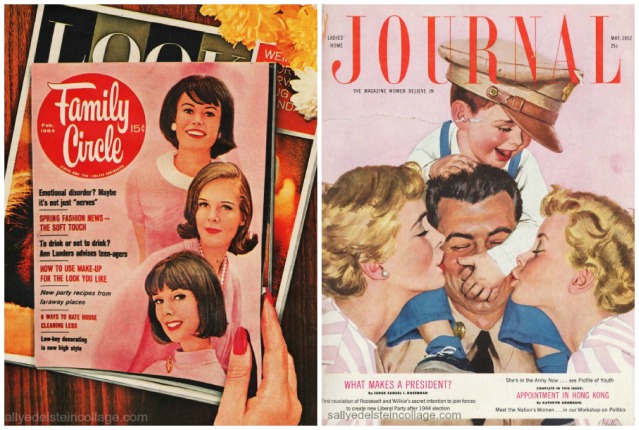
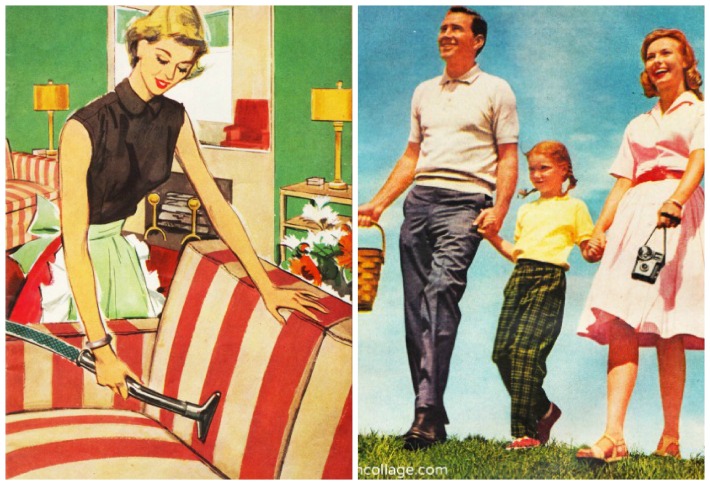

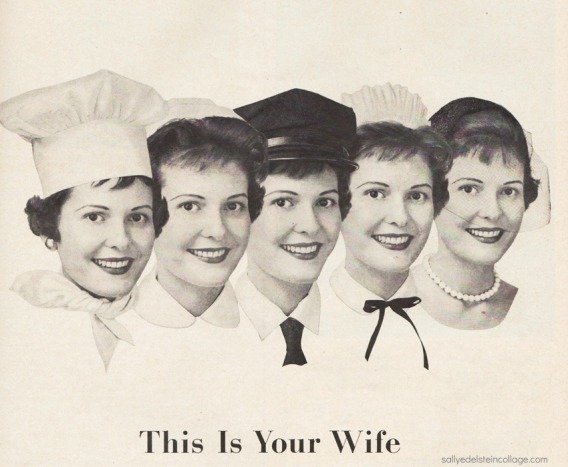

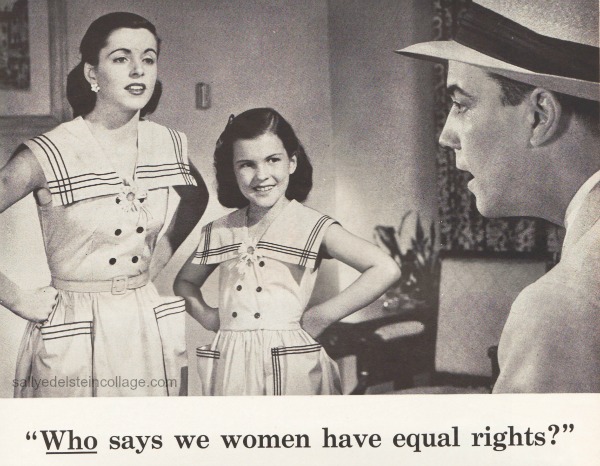
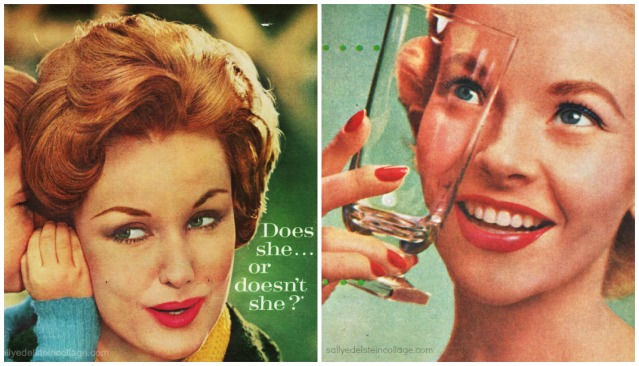
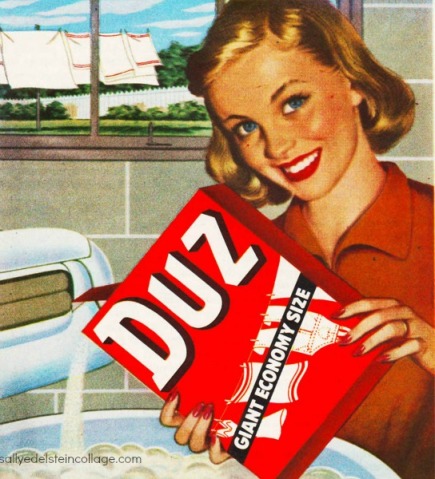
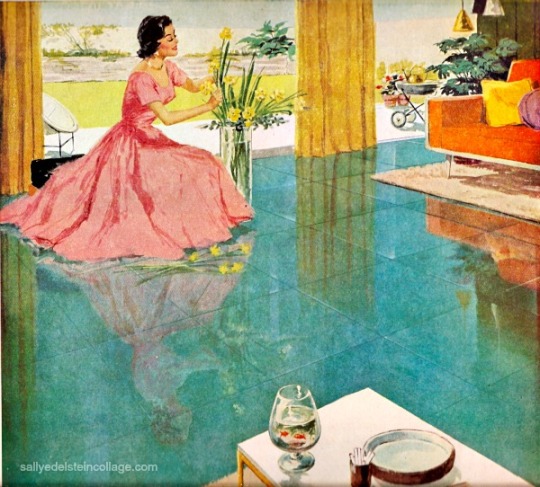





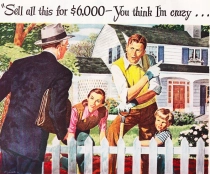
Excellent prologue to what was coming. Nice work.
LikeLike
Glad you enjoyed a bit of history!
LikeLike
Really enjoyed that one! Always look forward to your posts. Thank you.
LikeLike
Thanks John, and appreciate your support
LikeLike
Can I provide a soundtrack for this one. https://www.youtube.com/watch?v=sUzs5dlLrm0
LikeLike
Good choice!
LikeLiked by 1 person
“The Stepford Wives is a 1972 satirical thriller novel by Ira Levin. The story concerns Joanna Eberhart, a photographer and young mother who begins to suspect that the frighteningly submissive housewives in her new idyllic Connecticut neighborhood may be robots created by their husbands.”
The Stepford Wives > http://en.wikipedia.org/wiki/The_Stepford_Wives
The Stepford Wives (1975 film) > http://en.wikipedia.org/wiki/The_Stepford_Wives_(1975_film)
The Stepford Wives (2004 film) > http://en.wikipedia.org/wiki/The_Stepford_Wives_(2004_film)
http://www.harpercollins.com/9780062037602/the-stepford-wives
——————————
Egalitarianism turning into computer monitored mediocracy
Ira Levin “This Perfect Day”
http://en.wikipedia.org/wiki/This_Perfect_Day
Click to access Ira%20Levin%20-%20This%20Perfect%20Day.pdf
(http://softpedia.ws/files/ira%20levin%20this%20perfect%20day%20free%20download&id=my)
Kurt Vonnegut “Harrison Bergeron”
http://en.wikipedia.org/wiki/Harrison_Bergeron
Click to access bnw-unit_packet.pdf
(https://archive.org/stream/HarrisonBergeron/Harrison%20Bergeron_djvu.txt)
LikeLike
The Stepford Wives became sort of a metaphor for those times. Thanks for all the links
LikeLike
Really unique to see all the pictures and posters from the 60s. Interesting to see how women were portrayed in the media 60 years ago.
LikeLike
Pingback: Operation June Cleaver | Envisioning The American Dream
Pingback: A Test of Gender | Envisioning The American Dream
Pingback: Beer and the Happy Homemaker | Envisioning The American Dream
Pingback: Will Operation June Cleaver Be Deployed in 2020 | Envisioning The American Dream